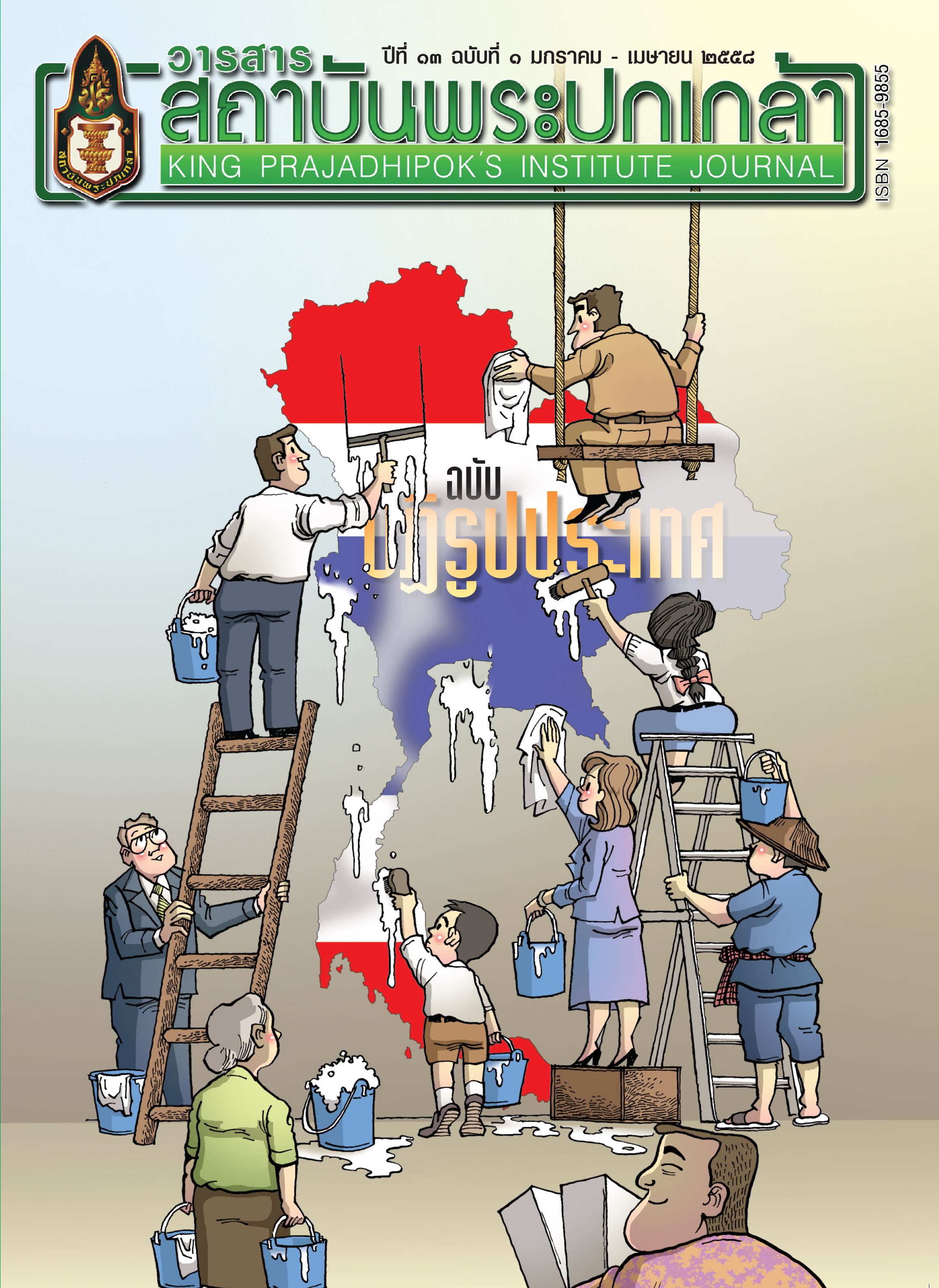การสร้างดุลอำนาจภายในรัฐสภา:บทสังเคราะห์และข้อเสนอแนะสำหรับการปฏิรูปโครงสร้างรัฐสภาของประเทศไทย
Main Article Content
บทคัดย่อ
บทความนี้มุ่งทบทวนและอภิปรายเกี่ยวกับโครงสร้าง และกระบวนการได้มาซึ่งสมาชิกรัฐสภา เพื่อเสนอแนะแนวทางที่เป็นไปได้และเหมาะสมสำหรับการสร้างดุลอำนาจภายในรัฐสภาไทย อาศัยการสังเคราะห์ผลการศึกษาที่ได้รับจากโครงการวิจัยที่ได้รับการสนับสนุนทุนวิจัยจากสถาบันพระปกเกล้า ๒ โครงการ บทความนี้เสนอว่าระบบสภาคู่ที่ประกอบด้วยสมาชิกสภาผู้แทนราษฎรที่มาจากการเลือกตั้งโดยตรงของประชาชนโดยใช้ระบบผสม และสมาชิกวุฒิสภาที่มีความยึดโยงกับประชาชนและมีองค์ประกอบหลากหลายเป็นระบบที่มีความเหมาะสมกับบริบททางการเมืองในปัจจุบันของประเทศไทยมากที่สุด อย่างไรก็ตาม เพื่อให้สมาชิกรัฐสภาสามารถทำงานได้อย่างมีประสิทธิภาพและรัฐสภาไทยเกิดดุลยภาพภายในอย่างแท้จริง การออกแบบเครื่องมือใหม่ๆ ให้สมาชิกรัฐสภาสามารถใช้อำนาจตรวจสอบและควบคุมได้อย่างมีประสิทธิผลและสอดคล้องกับผลประโยชน์ของประชาชน รวมถึงการมีมาตรการทางกฎหมายที่ช่วยยกระดับการทำหน้าที่ของพรรคการเมืองเป็นสิ่งที่ต้องให้ความสำคัญด้วย
Article Details
@ 2020 King Prajadhipok's Institute The Government Complex Commemorating All Right Reserved.
เอกสารอ้างอิง
แก้วสรร อติโพธิ และสุรพล นิติไกรพจน์. ๒๕๒๗. การสัมมนาวิชาการเมือง “ปัญหารัฐธรรมนูญและสถาบันการเมืองในสภาวการณ์ปัจจุบัน” ณ คณะนิติศาสตร์ มหาวิทยาลัยธรรมศาสตร์ ระหว่างวันที่ ๑๐ – ๑๑ สิงหาคม ๒๕๒๗.
ณัชชาภัทร อมรกุล. ๒๕๕๗. วุฒิสภาไทยอยู่ที่ไหนในโลก. สืบค้นวันที่ ๒๐ มิถุนายน ๒๕๕๗. จาก http://www.tpd.in.th/content/details_1.php?ID=000221&type=000004
ภูมิ มูลศิลป์. ๒๕๕๗. รายงานวิจัยที่มาและอำนาจวุฒิสภา. กรุงเทพฯ: สถาบันพระปกเกล้า. (อัดสำเนา).
วิษณุ เครืองาม. ๒๕๓๐. กฎหมายรัฐธรรมนูญ. กรุงเทพฯ : สำนักพิมพ์นิติบรรณาการ.
วุฒิสาร ตันไชย ปัทมา สูบกำปัง และสติธร ธนานิธิโชติ. ๒๕๕๗. รายงานวิจัยการเลือกตั้งสมาชิกสภาผู้แทนราษฎรที่ยุติธรรมและเป็นที่ยอมรับของทุกฝ่าย. กรุงเทพฯ: สถาบันพระปกเกล้า. (อัดสำเนา).
ศูนย์บริการข้อมูลและกฎหมาย. ๒๕๔๐. วุฒิสภาไทย. กรุงเทพฯ: สำนักงานเลขาธิการวุฒิสภา.
สถาบันพระปกเกล้า. ๒๕๕๕. การปฏิรูประบบรัฐสภา: มุมมองเชิงเปรียบเทียบ. กรุงเทพฯ: สถาบันพระปกเกล้า
Cooper, Harris and Larry V. Hedges. 2009. The Handbook of Research Synthesis and Meta-Analysis. New York : Russell Sage Foundation Publications.
“Countries Compared by Government > Legislative branch. International Statistics at NationMaster.com”, CIA World Factbooks 18 December 2003 to 28 March 2011. Aggregates compiled by NationMaster. Retrieved from http://www.nationmaster.com/country-info/stats/Government/Legislative-branch
Ezrow, Lawrence. 2010. Linking Citizens and Parties: How Electoral Systems Matter for Political Representation. New York: Oxford University Press.
Gallagher, Michael and Paul Mitchell. 2005. “Introduction to Electoral Systems.” In The Politics of Electoral Systems. edited by Michael Gallagher and Paul Mitchell. New York: Oxford University Press.
Goodwin-Gill, Guy S. 2006. Free and Fair Election: New Expanded Edition. Geneva: Inter-Parliamentary Union.
Morris, Caroline. 2012. Parliamentary Elections, Representation and the Law. Portland, Oregon: Hart Publishing.
Reeve, Andrew and Alan Ware. 1992. Electoral Systems: A Comparative and Theoretical Introduction. New York: Routledge.
Saini, Michael and Aron Shlonsky. 2012. Systematic Synthesis of Qualitative Research (Pocket Guides to Social Work Research Methods). New York: Oxford University Press.
Sénat. Formes et fonctions du bicamérisme. Retrieved June 6, 2014, from http://www.senat.fr/senatsdumonde/syntheselebicamerismedanslemonde.html
Strøm, Kaare. 2003. “Parliamentary Democracy and Delegation.” In Kaare Strøm, Wolfgang C. Müller, and Torbjörn Bergman, eds. Delegation and Accountability in Parliamentary Democracies. New York: Oxford University Press.
Taagepera, Rein. 2007. Predicting Party Sizes: The Logic of Simple Electoral Systems. New York: Oxford University Press.


